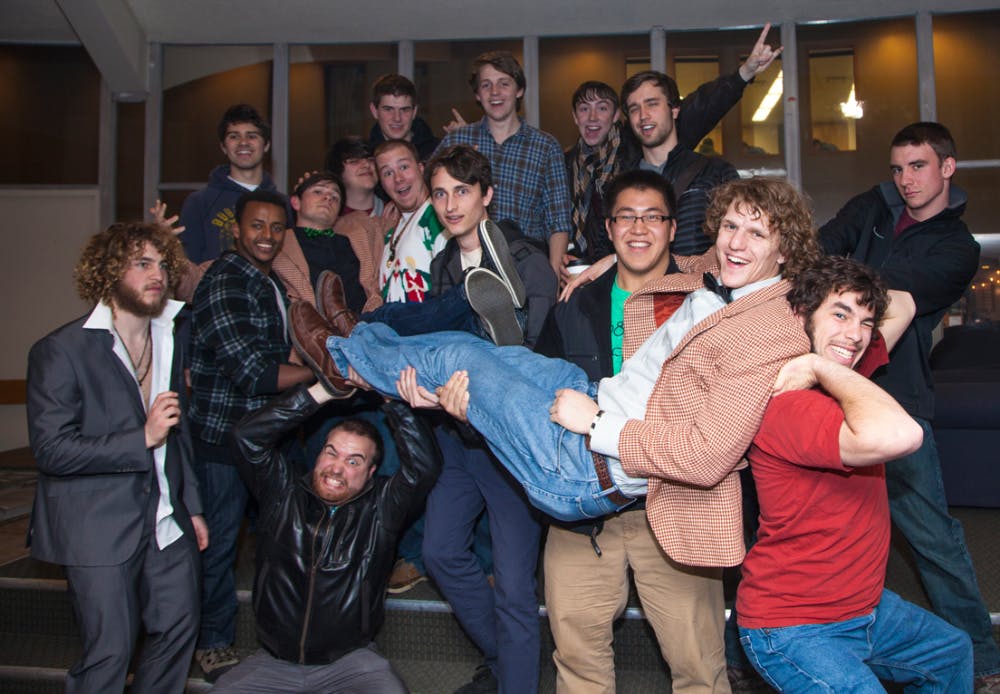By Nicole Arpin | Echo
In the bowels of the Modelle Metcalf Visual Arts Center, the Brotherhood's representatives stood front and center, modeling checkered sport coats and waiting for the crowd to hush.
"I know some of you may have been personally harmed by the Brotherhood in the past," sophomore Wilson Alexander began. "You may have been soaked with a water balloon, yelled at during dinner or had your bike zip-tied to a tree. But tonight, we are not here to talk about those instances. Tonight, we are here because Kasey and I believe in the reconciling and restoring power of the discipline of history."
The Bag and the Brotherhood
Alexander and his fellow historian, sophomore Kasey Leander, gave their "BroHo 101" presentation after taking an independent study J-Term class on the Brotherhood's history. Their research was inspired by the discovery of old Broho documents and by a Homecoming visit from the first Phubs, Todd Meissner, class of 1983.
"We (thought), 'You know what? There's a lot of tradition on the floor. I think it'd be cool to write some of this down,'" Leander said.
Alexander and Leander began their presentation by outlining the first years of Samuel Morris Hall. The first building, constructed in 1958, contained a very different dorm culture. Residence life revolved around intramural sports. Second West Wengatz, known as "The Association," dominated intramurals by recruiting the best athletes from every wing on campus. At that time, Third Morris, known as "The Bag," was fed up with the overpowering Wengatz men.
"Finally, in the spring of 1968, the men of The Bag determined that this had to stop. They took down the old burlap sack that was hanging in the floor lobby, and hung a sign reading 'The Brotherhood.' They began to systematically plan out how they were going to dominate intramurals, and did so with great success in the '70s," Wilson said.
"We didn't think there would be 'a moment' where the Brotherhood became the Brotherhood. It was really cool to find that," Leander said.
A Familial Floor
This new community of men on Third Morris emphasized inclusivity. Each resident of the Brotherhood was required to compete in an intramural sport, which prompted a spirit of unity among the men. Third Morris' new name reflected a change in floor identity; its residents wanted every member to feel like a brother.
The first Phubs, Todd Meissner, arrived at Taylor in 1979 during a pivotal moment in Broho's history. Former Broho resident Jim Wheeler had just died, and the Brotherhood was in grieving. That tragic event pulled the Brotherhood closer together.
"The upperclassmen were a very tight-knit group because they had been through the passing of this main character on the floor. They really reached out to the freshmen . . . . (The Brotherhood) really did operate as a family," Meissner said.
Just as children raised with an understanding of their family history have higher levels of emotional well-being, according to a study by Emory University, so the Brotherhood traces its sense of identity to its knowledge of floor history.
"I think the traditions and the craziness really create a sense of belonging. You think, 'This is where I live, so this is what we do,'" Alexander said.
TJ Lopez, a junior Personnel Assistant (PA) on Broho this year, agreed.
"The history of the Brotherhood has allowed Broho to form into a very communal, family-oriented floor," Lopez said.
A Fresh Future
Broho's history is full of mischief and zaniness, but Lopez hopes to channel the Brotherhood's energy into increasingly more positive channels.
"We're trying to start different traditions, and see how we can have our traditions be more toward a goal, rather than having them just for tradition's sake. Instead, they would be for the purpose of building community," Lopez said.
For example, the men have begun a new chapel tradition this semester. Every Monday, the Brotherhood sings "It Is Well With My Soul" at the end of chapel. This practice is deeply rooted in history; the Brotherhood first spontaneously sang this song at Jim Wheeler's memorial service in 1979. Just as Third West Wengatz's Friday Shirt helps celebrate the end of a week, Lopez hopes this tradition will encourage Taylor students on dreary Monday mornings.
"This (tradition) has more of an uplifting tone. We want our traditions to be more focused on a goal or more glorifying to God in some way," Lopez said.
To conclude the "BroHo 101" presentation, Leander announced his intentions to reveal the mystery of Court (an elusive Broho tradition). But before he could divulge its secrets, a masked band of Brotherhood members charged into the room.
"Hey! What are you guys doing?" shouted their leader as the group stormed Leander and Alexander.
The men of Third Morris forcibly removed their historian brothers in a howling mob, at which a spectator huffed and mumbled:
"Classic BroHo."





